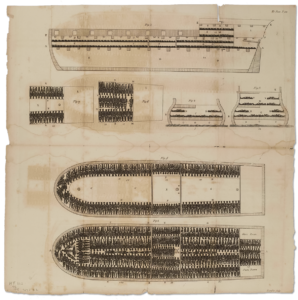In a monumental archaeological revelation, researchers have uncovered the largest cluster of sunken vessels from the 18th and 19th centuries off the coast of the Bahamas.
This discovery, reported by Alberge, marks a significant milestone in our understanding of the transatlantic slave trade, shedding new light on the harrowing experiences of enslaved Africans.

History and Archaeology
Led by the Bahamas Lost Ships Project and spearheaded by Allen Exploration, the exploration of these 14 wrecked slaver ships brings to the forefront the brutal realities of this dark chapter in human history.
The transatlantic slave trade, spanning over centuries, was one of the most reprehensible and morally abhorrent enterprises in human history.
During this period, millions of Africans were forcibly taken from their homelands and transported across the Atlantic Ocean under deplorable conditions to be sold into slavery in the Americas.

These ships served as grim vessels of human suffering, carrying enslaved individuals who endured unimaginable horrors throughout their journey.
The identification of these sunken slaver ships off the Bahamas coast provides tangible evidence of the scale and scope of the transatlantic slave trade. Each vessel represents a microcosm of the atrocities perpetrated against countless lives.
Transatlantic Slave Trade
Historians estimate that up to 12.5 million Africans were forcibly transported across the Atlantic, with millions perishing due to disease, starvation, and the brutal conditions onboard these ships.
The conditions onboard these slaver ships were nothing short of horrific. Enslaved Africans were packed tightly into the holds of the vessels, often chained together in cramped and unsanitary conditions.

Disease and malnutrition were rampant, claiming the lives of countless individuals before they even reached their destination. The discovery of these wrecked ships serves as a stark reminder of the inhumanity and cruelty inflicted upon those who were deemed less than human.
Also, read: Nollywood Mourns as Veteran Actor Mr Ibu Passes Away
Remembering History
One of the most poignant aspects of this discovery is the individual stories of resilience and survival that emerge from the wreckage. Survivors like Olaudah Equiano, whose autobiographical account shed light on the horrors of the slave trade, serve as beacons of hope amidst the darkness.
Their stories remind us of the indomitable human spirit and the capacity to endure even in the face of unimaginable adversity.
As the world commemorates Black History Month, the discovery of these sunken slaver ships provides an opportunity to reflect on the unfortunate legacy of slavery and its impact on society today. It is a reminder that the scars of slavery run deep and continue to reverberate through generations.
By acknowledging the past and confronting the uncomfortable truths of history, we can strive toward a more just and equitable future for all.
Supported by Allen Exploration, the Bahamas Maritime Museum plays a crucial role in preserving the artifacts recovered from these wrecks.
Artifacts and Archaeological Finds
These artifacts serve as tangible reminders of the human cost of the transatlantic slave trade and the need to remember and honor those who suffered. By preserving this history, we ensure that the voices of the past are not silenced and that their stories are told for generations to come.

Conclusion:
In conclusion, the discovery of these 14 sunken slaver ships off the Bahamas coast represents a pivotal moment in our understanding of the transatlantic slave trade.
It is a sobering reminder of the atrocities committed in the name of greed and exploitation. As we continue to unearth the secrets of the past, may we strive to learn from history and work towards a future where all individuals are treated with dignity, respect, and equality.

